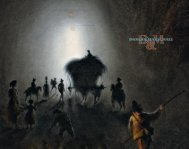Catalogue 2010 - daxer & marschall
Catalogue 2010 - daxer & marschall
Catalogue 2010 - daxer & marschall
Create successful ePaper yourself
Turn your PDF publications into a flip-book with our unique Google optimized e-Paper software.
JAMES JACquES JOSEPH TISSOT<br />
The Kitchen Garden<br />
66<br />
brick-built Gothic church and added house, creeper-covered buttresses and kitchen garden, appears<br />
in numerous paintings by Tissot. For example, The Convalescent (Art Gallery of Ontario, Toronto),<br />
dated 1870 or 1872, sets a white-clad figure by red-brick planters filled with ferns and exotic plants<br />
in various shades of green; and pictures set in Tissot’s London garden frequently include red/green<br />
juxtapositions of brick and vegetation, such as in the background of Matinée de Printemps (Collection<br />
of Mrs Wrightsman), dating from about 1874, to the several versions of La Soeur ainée, about 1881-82,<br />
showing Kathleen Newton seated on the steps leading down from the studio or conservatory to the<br />
garden.<br />
Tissot had an astounding facility with paint and could give the impression of particular plants<br />
or objects through a touch or swirl of his brush. The deft way in which are painted the cabbages,<br />
sunflowers and crookedly angular tree branches in Le Presbytère recall passages in Matinée de Printemps<br />
and other garden paintings such as En plein soleil (Collection of Mrs Wrightsman). Small dabs of red<br />
or yellow to indicate the blooms of geraniums, nasturtiums or sunflowers are a device used by Tissot<br />
to draw the eye and enliven the painting, and flicker across many of his garden paintings in the same<br />
way that they do in Le Presbytère.<br />
A black cat walking across the cinder footpath in the background of En plein soleil echoes the<br />
tabby cat in the foreground of Le Presbytère, whose stripes enhance the animation given to the scene<br />
by the movement of this animal caught as in a snapshot photograph. The cat has turned its head<br />
and stares out at the painter and us, the viewers. Tissot frequently included a figure looking out and<br />
directly engaging the viewer, though it was more usually a woman in this role than a cat.<br />
The technique of painting in oils on a reddish-brown prepared ground, which is employed<br />
in Le Presbytère, was one favoured by Tissot for sketches and compositional studies. He would rough<br />
out the composition with pencil or dark paint then fill in areas of sky or highlights with toned white<br />
oil paints, in a similar way to the painting of the sky to the left of the tree in Le Presbytère. Touches of<br />
colour were then added but the ground showed through to a greater or lesser extent, giving overall<br />
tone and body and saving the time that would be needed to fill in dark areas on a pale ground. use<br />
of a dark ground in this way was common practice among French artists. Le Presbytère has a level of<br />
detail that is more usually found in Tissot’s paintings on wooden panels or canvas. This suggests it was<br />
a picture created impromptu with sketching materials the artist had to hand, painted on the spot en<br />
plein air. Pin-holes in the corners indicate where the card was pinned to a wooden board for support<br />
while working.<br />
Krystyna Matyjaszkiewicz, 12 October 2009<br />
Krystyna Matyjaszkiewicz is currently writing a book on James Tissot to be published by Phaidon Press. She organised and selected Tissot<br />
exhibitions for the Barbican Art Gallery, London/Whitworth Art Gallery, Manchester and Musée du Petit Palais, Paris in 1984-85, and<br />
for Brain Trust Inc, Tokyo, in 1988, and worked as a curator, arts officer and editor before returning to research in recent years while<br />
continuing to work in museums. She is also the world expert on the British and European pictures of 19th century artist David Roberts.






